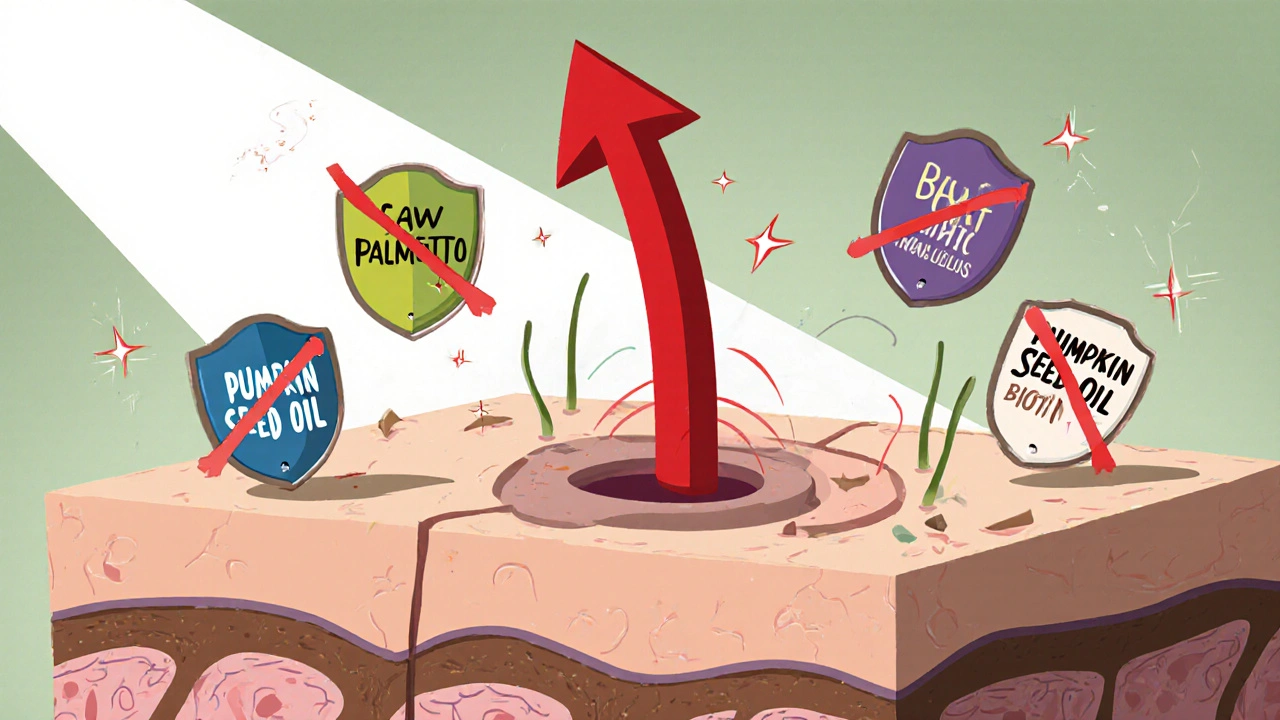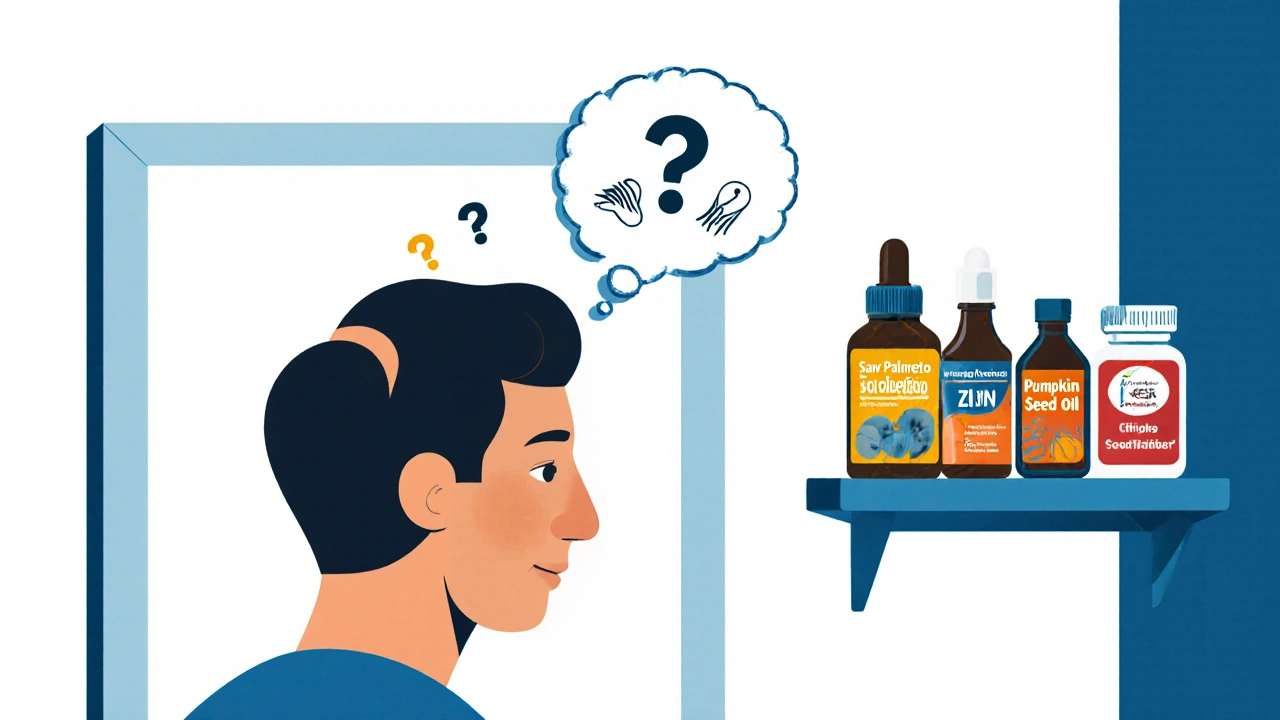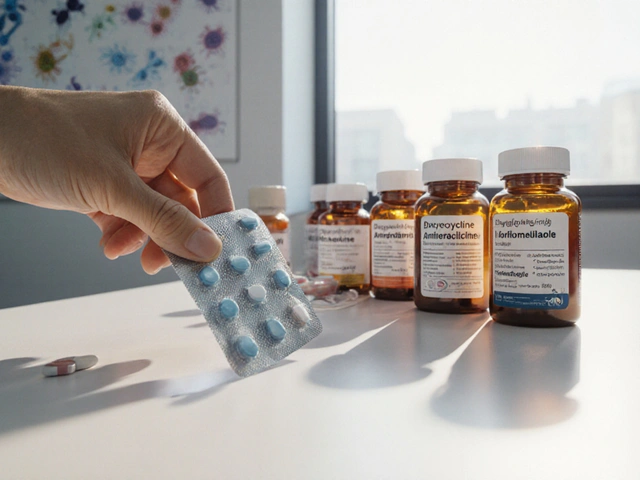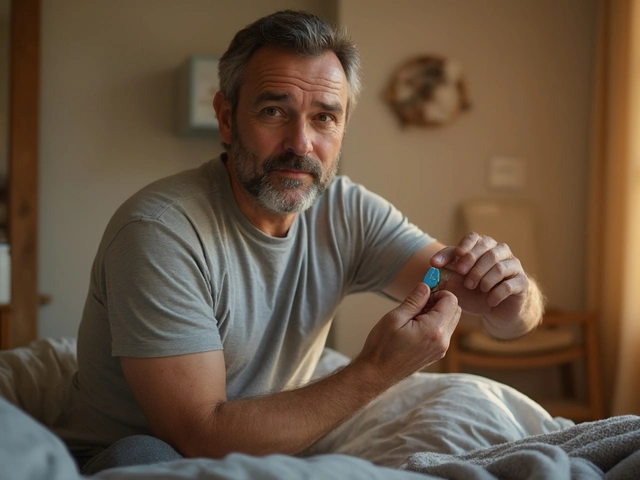Hair Loss Supplement Effectiveness Estimator
Assess Your Supplement Potential
This tool estimates effectiveness of hair loss supplements based on clinical evidence and your specific situation. Results are estimates only and not medical advice.
320 mg/day
2 g/day
2.5 mg/day
30 mg/day
2000 IU/day
Your Supplement Effectiveness Score
Key Recommendations
Timeline Expectations
Noticeable results typically take 3-4 months due to hair cycle timing. Expect:
- 1-2 months: Initial stabilization of shedding
- 3-4 months: Visible density improvements
- 6 months: Maximum effect
If you’re staring at a thinning crown and wondering whether a bottle on the shelf can actually help, you’re not alone. Millions grapple with Androgenic Alopecia - the hormone‑driven pattern loss that shows up as receding hairlines in men and diffuse thinning in women.
What makes the search for a cure so confusing is the flood of supplements promising miracles, many of which lack solid science. Below you’ll find a straight‑talk guide that separates the credible from the hype, shows how to read the fine print, and helps you build a safe, evidence‑based routine.
Quick Takeaways
- Only a handful of ingredients - saw palmetto, pumpkin seed oil, and specific vitamins - have modest clinical backing.
- Topical FDA‑approved drugs (minoxidil) still outperform most oral supplements.
- Check serum DHT levels, iron status, and thyroid function before relying solely on supplements.
- Watch for interactions with prescription DHT blockers like finasteride.
- Start with a low dose, track progress for 3-6 months, and stop if side effects appear.
Understanding the Hormone Playbook
The core driver of Androgenic Alopecia is the conversion of testosterone into Dihydrotestosterone (DHT) by the enzyme 5‑alpha‑reductase. DHT shrinks hair follicles, shortens the growth cycle, and eventually leads to miniaturized, barely visible hairs.
Because DHT is the culprit, many supplement makers market “DHT‑blocking” ingredients. But not all blockers are equal, and not all claim‑backed ingredients actually affect the enzyme at a dose you can realistically take.
Prescription vs. Over‑the‑Counter: Where Do Supplements Fit?
Two FDA‑approved options dominate the market:
- Finasteride - a 5‑alpha‑reductase inhibitor taken orally (1mg for men, 5mg for BPH). Clinical trials show 30‑50% regrowth in men after 12months.
- Minoxidil - a topical vasodilator applied twice daily. Works for both sexes; about 25% see visible thickening after 6months.
Supplements sit below this tier. They can complement prescription therapy or serve as a first step for those hesitant about medication. The key is to know which ingredients have measurable impact.
What the Science Says: Top‑Rated Ingredients
| Ingredient | Mechanism | Clinical Evidence | Typical Dose | Common Side Effects |
|---|---|---|---|---|
| Saw Palmetto | Partial 5‑alpha‑reductase inhibition | Moderate - 2‑month RCT showed 15% increase in hair density vs. placebo | 320mg/day (standard extract) | Mild stomach upset, occasional dizziness |
| Pumpkin Seed Oil | Phyto‑DHT blockade, anti‑inflammatory | Weak - single‑blind study (100mg) reported 12% improvement over 24weeks | 2g/day (capsule) | None reported in most trials |
| Biotin (VitaminB7) | Supports keratin production | Weak - benefit mainly for biotin‑deficient individuals | 2.5mg/day | Rare skin rash |
| Zinc | Inhibits 5‑alpha‑reductase, improves follicle health | Moderate - 3‑month trial showed 9% increase in hair count | 30mg/day (as zinc gluconate) | Nausea, copper deficiency with long‑term high dose |
| Vitamin D | Regulates hair‑cycle signaling | Weak - observational studies link low levels to alopecia, supplementation data limited | 2000IU/day | Hypercalcemia if excessively high |
Notice how the strongest data comes from saw palmetto and zinc. Pumpkin seed oil and biotin can help, but the numbers are modest. Vitamin D is more of a “fix deficiency” move than a direct hair‑growth catalyst.

How to Vet a Supplement Before Buying
- Check the label for standardized extracts. “Saw palmetto 320mg” should specify a percentage of fatty acids (usually 45‑55%).
- Look for third‑party testing (USP, NSF, ConsumerLab). This reduces the risk of contaminants or mislabeled potency.
- Beware “proprietary blends.” They hide exact amounts, making it impossible to compare doses.
- Read the ingredient list for fillers like magnesium stearate or artificial colors - they don’t add value and can irritate sensitive stomachs.
- Search PubMed or ClinicalTrials.gov for the specific dosage used in studies. If the product delivers half the studied amount, the evidence may not apply.
Safety First: Interactions and Contra‑Indications
Even “natural” compounds can clash with prescription meds. Saw palmetto may amplify the effect of finasteride, potentially causing excess hormonal imbalance. Zinc at high doses interferes with copper absorption, leading to anemia. Vitamin D excess can raise calcium, stressing kidneys.
Before starting any supplement, get baseline labs:
- Serum DHT (if available) or total testosterone.
- Ferritin and iron - iron deficiency is a hidden cause of thinning hair, especially in women.
- Thyroid panel - hypothyroidism mimics androgenic alopecia.
- Vitamin D level.
If any values are abnormal, address those first; a supplement won’t fix a deficiency.
Putting It All Together: A Sample 3‑Month Protocol
Here’s a practical plan that blends evidence‑based supplements with lifestyle tweaks. Adjust based on your own labs and any prescription meds you’re already using.
- Morning: Saw Palmetto 320mg with breakfast.
- Midday: Zinc 30mg (take with food to avoid nausea).
- Evening: Pumpkin Seed Oil 2g capsule after dinner.
- Daily: Vitamin D 2000IU, especially if you live in higher latitudes like Halifax.
- Optional add‑on: Biotin 2.5mg if you have signs of brittle nails or hair that feels unusually weak.
- Topical support: Minoxidil 5% foam twice daily (the only over‑the‑counter product with strong FDA data).
Track progress with monthly photos and a simple scalp‑density count (how many hairs you can see in a 1cm² window). Expect noticeable change after 12-16weeks; if nothing improves, consider stopping the regimen and consulting a dermatologist.
Common Myths That Keep People Stuck
- Myth: “If it’s natural, it can’t cause side effects.”
Fact: Saw palmetto can lower prostate‑specific antigen (PSA) readings, confusing cancer monitoring. - Myth: “More of a supplement means faster results.”
Fact: Exceeding studied doses often adds no benefit and raises risk of GI upset or mineral imbalances. - Myth: “Hair loss stops after a few weeks of treatment.”
Fact: The hair cycle is slow; a full follicle turnover takes 3-4months, so patience is required.
When to Seek Professional Help
If you notice:
- Rapid shedding (>100 hairs per day)
- Patchy bald spots that expand
- Scalp inflammation, pain, or itching
- No improvement after 6months of a disciplined supplement regimen
These signs point to underlying issues beyond simple hormone‑driven thinning. A dermatologist can perform a scalp biopsy, rule out alopecia areata, or prescribe stronger systemic treatments.
Bottom Line
While no supplement can rival the proven power of prescription finasteride or minoxidil, a handful of nutrients - especially saw palmetto, zinc, and adequate vitaminD - can modestly boost hair density when used correctly. The trick is to choose standardized products, respect dosages, monitor labs, and stay realistic about timelines.
Frequently Asked Questions
Can women use saw palmetto safely?
Yes, most studies focused on men, but women have used 320mg daily without major side effects. Pregnant or breastfeeding women should avoid it because hormonal effects are not fully understood.
How long before I see results from supplements?
Typically 12-16weeks. Hair cycles are slow, so you need at least three months of consistent dosing before any thickening becomes visible.
Do I need to combine supplements with minoxidil?
Combining works best for many people. Minoxidil addresses the follicle’s blood flow, while supplements target hormonal pathways. Using both can give a synergistic edge, but monitor for scalp irritation.
Is there a risk of nutrient toxicity with these supplements?
Vitamin D and zinc can become toxic at very high doses. Stick to the recommended daily amounts and get periodic blood tests.
Should I get my DHT levels tested before starting?
If you can access the test, it helps tailor treatment. Elevated DHT confirms the hormonal angle, but many clinicians treat based on clinical pattern alone.








10 Comments
Kevin Adams
October 16, 2025 AT 19:12When the mirror shows a thinning crown, one feels the weight of centuries pressing upon the scalp; the battle against DHT becomes a personal mythic quest. The ancient alchemists whispered of herbs that could tame the roaring lion of testosterone, yet modern science demands proof in the crucible of trials. Saw palmetto, that humble berry, has emerged as a modest guardian, offering a 15% increase in density according to a short‑term study. Zinc, the mineral of ancient warriors, stands beside it, delivering a 9% rise in hair count when taken consistently. Pumpkin seed oil, though praised by the masses, only nudges the numbers by a whisper of twelve percent. Biotin, the darling of influencers, merely shines for the truly deficient. Vitamin D, the sun’s promise, corrects deficiencies but does not conjure strands from void. The crux lies in standardized extracts-do not be fooled by proprietary blends that hide their true potency. Third‑party testing is the shield against contaminants and false claims. Tracking progress with monthly photos transforms vague hopes into measurable data, allowing the practitioner to adjust dosage or abandon a futile regimen. Patience, the silent partner, must accompany you, for hair cycles demand three to four months to reveal any change. Always cross‑reference supplements with lab work: DHT, ferritin, thyroid, and vitamin D guide the journey. Interactions with finasteride can amplify effects, for better or worse, demanding vigilant monitoring. While no supplement will outrun minoxidil or finasteride, a disciplined trio of saw palmetto, zinc, and vitamin D can tip the scales toward modest regrowth. Remember, the scalp is a battlefield; the weapons must be chosen with evidence, not hype. In the end, humility before the science and a willingness to adapt are the true keys to reclaiming a fuller crown.
Katie Henry
October 23, 2025 AT 12:19Dear community, I encourage you to approach hair‑loss supplementation with disciplined optimism. Conduct baseline labs, choose standardized products, and monitor progress diligently. Consistency and patience will serve you well on this journey toward healthier hair.
Joanna Mensch
October 30, 2025 AT 04:26It’s worth noting that many supplement companies are financed by shadowy networks aiming to keep us dependent on endless product cycles. Their marketing hides the fact that some ingredients are deliberately under‑dosed to protect ongoing profits.
RJ Samuel
November 5, 2025 AT 21:32I’m not buying the hype that every bottle on the shelf is a miracle cure. The data shows only a handful of compounds have modest effects, and most are nowhere near the power of prescription meds. Let’s cut the nonsense and stick to what the studies actually prove.
Nickolas Mark Ewald
November 12, 2025 AT 14:39Sounds like a solid plan. I’d add that keeping a simple daily log helps you see whether the routine is working without overcomplicating things.
Chris Beck
November 19, 2025 AT 07:46All these foreign “natural” pills are just a ploy to weaken our own health. Stick to home‑grown solutions and don’t let outsiders dictate your scalp’s fate.
Sara Werb
November 26, 2025 AT 00:52Honestly the kinda supplements they push are a total scam!!! They want us to buy endless bottles while they hide the real cure!! It’s all a massive con and you’re being duped!!!
Winston Bar
December 2, 2025 AT 17:59Yeah, I guess the whole thing is kinda boring… Everyone’s talking about “evidence” but honestly, who has the time to track hair counts for months? Just give me a pill and call it a day.
Russell Abelido
December 9, 2025 AT 11:06I hear you, Winston. While the process can feel tedious, keeping a simple photo log can actually be pretty empowering 😊 It lets you see real change without guesswork.
Steve Holmes
December 16, 2025 AT 04:12Interesting points all around! The blend of minoxidil with a modest supplement stack seems like the most balanced approach, as long as you stay within studied dosages.